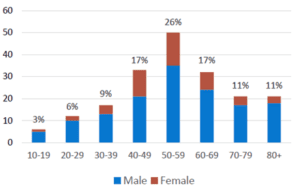 By Kara Connors, MPH, Senior Program Coordinator for Suicide Prevention and Dr. Jei Africa, PsyD, Director, Marin County Behavioral Health and Recovery Services.
By Kara Connors, MPH, Senior Program Coordinator for Suicide Prevention and Dr. Jei Africa, PsyD, Director, Marin County Behavioral Health and Recovery Services.
Suicide prevention among older adults has received increased attention with the emergence of Covid and the need to shelter in place. Being in quarantine has compounded common pre-Covid experiences such as ageism, stigma, discrimination, isolation, trauma, loss of usual activities, and connection to others. The anticipated impact of this “perfect storm” on the mental health status of aging adults, paired with substance use, may signal an increase of desperation or suicidal risk. Despite these uncertain times, the possibility of hope can be found in our understanding of suicide prevention, particularly in later years, and the role each of us can play in this important public health issue. As we honor September Suicide Prevention and Recovery Month, how might we help create a safer and healthier community for those in distress?
The projected increase in growth of Marin’s aging population in the next decade and prevalence of suicidal risk can shed light on one path we can take. Often older adults experience higher rates of suicide than other segments of the population due to: their frailty; isolation; reluctance to admit to thinking about suicide or asking for help; being more planful; having low treatment and detection rates for depression; and the belief that depression is a “natural” part of aging. Older LGBT adults are at greater risk to attempt suicide. In our community, male residents in middle age and older are disproportionately affected by suicide with 74% of total deaths by suicide in Marin County occurring (Figure 1). Rates for women drop from their peak in middle age (40-59). Not counted in these statistics are “silent suicide” deaths from overdoses, self-starvation or dehydration, and “accident.” (Gramaglia et al.)
Figure 1. Deaths by Suicide in Marin County (2014-2018), Organized by Age and Gender
 This alarming data does not, however, tell the full narrative of our understanding of suicide. A survey conducted by the American Foundation of Suicide Prevention indicates that the majority of Americans believe that suicide can be prevented, most want to help but feel we lack the words to help. Marin residents also reported in a recent needs assessment that they want to talk to a friend/loved one about the issue of suicide (Chambers et al.). These are powerful collective findings that can support our prevention efforts.
This alarming data does not, however, tell the full narrative of our understanding of suicide. A survey conducted by the American Foundation of Suicide Prevention indicates that the majority of Americans believe that suicide can be prevented, most want to help but feel we lack the words to help. Marin residents also reported in a recent needs assessment that they want to talk to a friend/loved one about the issue of suicide (Chambers et al.). These are powerful collective findings that can support our prevention efforts.
What Role Can You Play?
Each one of us, regardless of our background, can play an important role taking life saving actions, including:
Know the signs. Most people who feel suicidal are ambivalent about taking their life but express warning signs through feelings, words or actions, including: feeling burdensome, grief, chronic pain, hoarding/stopping medications, having access to lethal means, talking about suicide, and changes in substance use.
Identify and address risk and protective factors. Protective factors include caring for mental and physical health problems, creating social connectedness, and building skills in coping/adapting to change. Major risk factors, such as depression and substance use, can intensify other risk factors such as medical illness, financial trouble, neurocognitive conditions and grief.
Ask directly. Though it may feel difficult, asking directly will not give someone the idea to take their life (“are you having thoughts of suicide?”). Consider the different sociocultural beliefs of the person you are supporting (Each Mind Matters). Those with long standing relationships with their aging clients/loved ones can ask about suicidality utilizing risk assessment tools such as the Columbia-Suicide Severity Rating Scale (C-SSRS).
Listen and refer to help. Listen without judgement (“I am here for you”) and then immediately refer them to help (e.g., therapist, hotline, etc.). Conducting a collaborative safety plan, such as My 3 App, can address important protective factors, such as healthy coping strategies (eg., listening to music, practicing traditions/rituals, etc.).
Follow-up. Follow up contact by phone, text, or even a caring card, shows your support and fosters a sense of belonging.
Become an ally and get active! One way to make a difference in suicide prevention is to participate in the Marin County Suicide Prevention Collaborative. The focus of the Collaborative is to implement a strategic plan that focuses on prevention and intervention across the life span. Visit: https://www.marinhhs.org/bhrs-community-events
As we build our capacity and knowledge in learning how to reach out and communicate with our diverse aging friends and clients, we can identify and address signs of distress with more precision and confidence and “up” our ground game to build an inclusive and connected safety net that is supportive and life saving for all.
Note: If you or someone you know is suicidal or in distress, please contact the Buckelew Suicide Prevention Hotline (Marin: 415-499-1100) or the BHRS Access Line: 1-888-818-1115.
Citations:
American Foundation for Suicide Prevention. Public Perception of Suicide Prevention Survey Results September 2018.
Chambers et al. Marin County Suicide Prevention Strategic Plan. Research Development Associates. 2019
Each Mind Matters: https://www.eachmindmatters.org/product/know-signs-brochures-diverse-communities/
Gramaglia et al. Rational Suicide in Late Life. A Systemic Review of the Literature. Medicine. 2019


